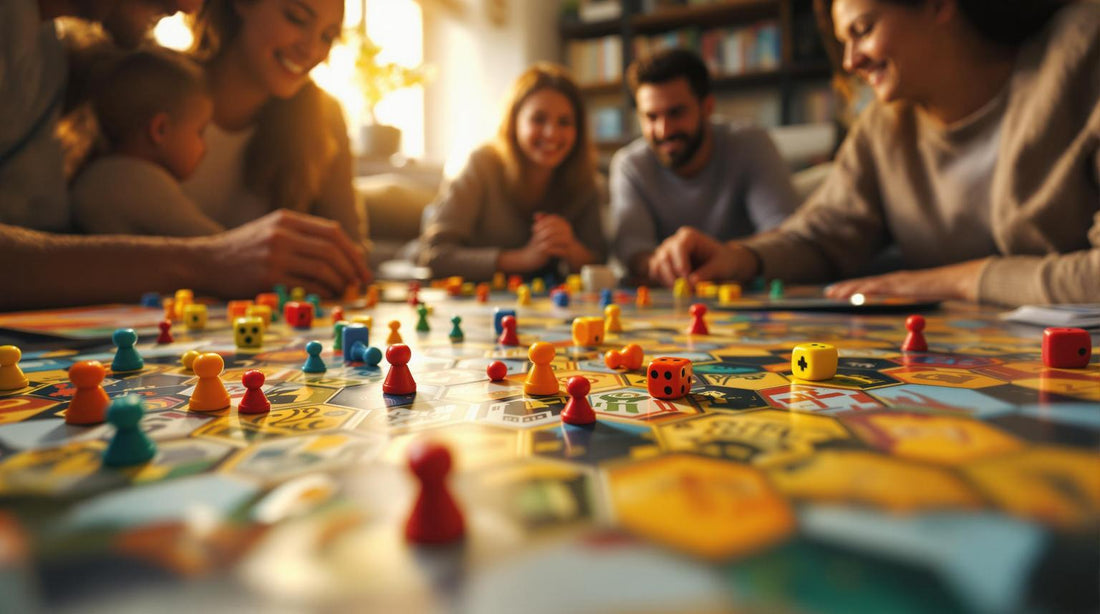Discover the Best Board Games for Every Player

How Game Mechanics Impact Replayability
Replayability keeps players coming back to games, and it’s all about the mechanics. Here’s a quick breakdown:
- Video Games: Use tools like procedural generation (Hades, Minecraft) and adaptive AI (Left 4 Dead 2) to create endless new experiences.
- Board Games: Rely on modular setups (Catan, Dominion) and strategic variability (Root, Gloomhaven) for unique sessions.
- Player Choices: Branching stories (Detroit: Become Human) and character builds (Divinity: Original Sin 2) boost replay rates by up to 2.5x.
- Multiplayer: Social interaction and competition in games like League of Legends and Diplomacy increase retention by 20%.
Quick Comparison:
| Feature | Video Games | Board Games |
|---|---|---|
| Randomization | Procedural generation | Shuffling cards, dice rolls |
| Content Variety | AI-driven systems | Modular components |
| Social Interaction | Online matchmaking | Face-to-face interaction |
Replayable games balance randomness, strategy, and player choice to stay engaging, whether digital or physical.
What Makes A Game Replayable?
Core Mechanics That Drive Replay Value
Games like Hades and Catan have set the bar for replayability, and modern titles are taking these ideas even further.
Take Minecraft, for example. Its procedural generation system creates an astounding 18 quintillion possible worlds. This feature has played a huge role in its popularity, with 141 million monthly active users. Similarly, No Man's Sky uses algorithms to generate over 18 quintillion planets, showcasing how endless digital variations can keep players coming back.
In the world of board games, replayability often hinges on smart use of physical components. Dominion, for instance, offers 5 trillion possible game setups using just 25 card types, with only 10 used per game. This design has helped the game sell over a million copies, proving how variety drives long-term interest.
| Replayability Feature | Digital Implementation | Physical Implementation | Impact on Engagement |
|---|---|---|---|
| Content Generation | Algorithmic world creation | Modular boards and components | +200% content variety |
| Randomization | AI-driven dynamic systems | Shuffled cards and dice mechanics | +30% player engagement |
| Setup Variation | Automated scene generation | Manual component arrangement | 78% player satisfaction |
Video games also use adaptive systems to keep things fresh. For example, Left 4 Dead 2 employs an AI Director that adjusts enemy spawns and item placements based on how players are performing. This dynamic approach has kept the game relevant, with over 30,000 concurrent players even a decade after its release.
On the board game side, Gloomhaven stands out with its modular board setups and 95 different scenarios. Playtesters reportedly put in an average of 150 hours before running out of content, showing how mechanical variety can directly impact player retention.
Replayability also benefits from balancing randomness and strategy. XCOM 2 uses "controlled randomness" to maintain a challenging but fair experience, while Puerto Rico relies on strategic role-selection mechanics to keep players engaged. Both examples highlight how carefully designed systems can make replayability a core part of the experience.
Games that focus on replayability often see a 30% boost in player engagement compared to more linear designs. These mechanics are the foundation for deeper player involvement, which we'll explore next.
Player Choices and Game Depth
While core mechanics set the stage, it’s the decisions players make that keep them coming back. Detroit: Become Human is a great example, offering a branching narrative where choices lead to vastly different outcomes. Games with multiple endings have been shown to increase replay rates by 2.5 times compared to linear stories.
Diverse character builds and varied gameplay styles also encourage replayability. Divinity: Original Sin 2 nails this with its skill trees and class combinations, prompting many players to complete 5-10 full playthroughs just to try out different setups. In fact, 78% of players are more likely to replay games that offer distinct playstyles. Board games like Root take a similar approach with unique faction rules and victory conditions, keeping each session fresh.
Optional goals can also enhance replay value. For instance, The Legend of Zelda: Breath of the Wild uses its shrine system to encourage exploration and achievement-driven play. Data shows players are highly engaged by these kinds of optional challenges. In board games, legacy mechanics take this a step further by introducing permanent, story-driven changes.
"Legacy elements create campaign replayability through permanent narrative-driven changes and unlockable content."
Difficulty scaling adds another layer of engagement by offering challenges tailored to different skill levels. Celeste does this brilliantly with its B-Side and C-Side levels, and 78% of its players attempt these tougher modes after finishing the main game.
All these elements - player choice, customization, optional objectives, and difficulty scaling - combine to create dynamic gameplay experiences. When you add multiplayer into the mix, player interactions introduce even more complexity and depth, making these systems even more compelling.
sbb-itb-1ed942f
Multiplayer Elements and Replayability
Multiplayer mechanics add a layer of unpredictability that significantly enhances replayability. According to data, games with multiplayer features show 20% higher player retention rates compared to single-player games.
Online multiplayer games and traditional board games achieve this in different ways. For example, Counter-Strike: Global Offensive keeps players engaged with its competitive matchmaking system, requiring constant strategy adjustments against human opponents. On the other hand, board games like Diplomacy rely on face-to-face negotiations and non-verbal communication, creating a social dynamic that keeps players coming back.
Cooperative gameplay also plays a key role in replayability. Take Pandemic, for instance, which uses randomized card decks and unique player abilities to create fresh challenges every time. This approach has contributed to a 30% annual growth in cooperative board game sales since 2017.
"The social connections formed through multiplayer games are a primary motivator for continued play, with some players returning to games primarily for the social experience rather than the gameplay itself."
Competitive systems offer another way to keep players engaged. League of Legends, for example, uses ranking systems and seasonal updates to maintain interest. These features help explain why competitive games remain immensely popular.
Player count flexibility is another factor in replayability. Digital shooters like Team Fortress 2 use role specialization to accommodate various team sizes, while board games adjust rules for different numbers of players. Innovations such as cross-platform play in games like Rocket League and legacy mechanics in board games, which introduce persistent changes across sessions, have further expanded multiplayer possibilities.
The best multiplayer experiences strike a balance between social interaction and engaging mechanics, creating a mix of competition and community that keeps players returning for more.
Comparing Video Game and Board Game Mechanics
Multiplayer dynamics play a big role in replayability, but the core differences between digital and physical formats lead to distinct ways of keeping players engaged. Video games leverage technology to implement mechanics that wouldn't work in physical formats, while board games thrive on tangible components and in-person interaction.
Take video games like Hades, which use procedural generation to create endless variations. In contrast, board games rely on physical randomization methods, such as the shuffled cards in Dominion. These differences define how each medium approaches keeping players coming back for more.
| Aspect | Video Game Approach | Board Game Approach |
|---|---|---|
| Randomization | Procedural generation, algorithms | Shuffling cards, rolling dice |
| Social Interaction | Online matchmaking, remote play | Face-to-face interaction, table talk |
Video games also shine with dynamic difficulty adjustment, where the game adapts to the player’s skill level. Board games, on the other hand, usually rely on players improving their skills naturally over time, uncovering deeper strategies with repeated play.
Emergent gameplay takes on unique forms in each medium. For example, The Legend of Zelda: Breath of the Wild uses physics engines and systemic design to create surprising interactions. Board games like Cosmic Encounter achieve this through player negotiations and alien power combinations, keeping gameplay fresh and unpredictable.
While both formats face their own limitations - technical challenges for video games and physical constraints for board games - the lasting nature of a board game's components often gives it an edge in terms of replayability, especially as digital games can become outdated due to aging hardware.
Conclusion
Digital and physical games may use different tools, but they share common principles when it comes to keeping players coming back. Replayability heavily relies on game mechanics that are designed to create dynamic and engaging experiences. The best results often come from blending several approaches, like procedural generation and giving players meaningful choices.
Good design strikes a balance between structured gameplay and unexpected possibilities. This mix tackles the key challenge of keeping things fresh without losing the structure that makes a game enjoyable. Our comparison highlights that successful replayability often depends on hybrid methods - merging the flexible systems of video games with the hands-on interactivity of board games.
To make this work, thorough playtesting and player feedback are crucial. Whether it’s the AI systems in video games or the variability of physical components in board games, the mechanics must evolve while staying true to what makes them fun in the first place. The real goal is to deliver new experiences without losing the core elements that initially draw players in.






